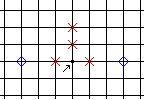|
|
Renju
You can play Renju now
 using my program
X & O using my program
X & O
Rules
Besides the two basic rules
the following rules are used in Renju
The rules marked with -
- * are not supported by this application
- ~ are optional for this application
- Rule 3. Black is prohibited from making a
double-three, a
double-four and an
overline.
If Black makes one of these patterns either accidentally or by
being forced to, he loses the game.
- Rule 4. White is not subject to any
restrictions and may make
double-threes,
double-fours, and
overlines,, an
overline having the same value for him as a five.
Observe that the double-three is counted as a
forbidden double-three only
if it is in principal not possible to
stop for the opponent who has nothing to attack with and who is
only playing defensive. For example if there is only space for 5
stones in a line it is not necessary to stop a three on this line.

The move on spot marked as black point is
allowed for Black. The opponent is able to stop the other three
and black cannot win with the three limited within 5
intersections.
- Rule 5. If neither player has succeeded in
making a row of five stones when the board has been played out,
the game is called a draw. It is also possible to agree on draw.
- Opening rules:
- Rule 6. In starting the game, a tentative
Black, and subsequently a tentative White, are decided between
each other.
- Rule 7. The tentative Black plays the 1st move
on the center intersection.
- *Rule 8. The tentative Black also decides where
the next move for White should be put. This White’s 1st move
and the 2nd move in the game must be played direct or indirect.
"Direct" means a move made horizontal or vertical to
the 1st move and in direct connection with the 1st move.
"Indirect" means a move made diagonal to the 1st move
and in direct connection with the 1st move.
X & O does not support directly this rule.
But you can very easy play game according this rule:
- set x and o as humans
- let x do the first and the second move
- if you play with computer set x or o as computer
- Rule 9. The tentative Black plays the 3rd move
on an empty place within a zone of 5x5 intersection with the same
center as the center intersection of the whole board.
- ~Rule 10. Black has decided where the first
three stones, two for Black and one for White, should be put.
Seeing the opening pattern that tentative Black has chosen, the
tentative White has the right to change sides. If he prefers
Black, he changes sides, gives white stones to his opponent, and
receives black stones. If, however, he prefers to continue the
game with white stones, nothing happens and he simply plays the
4th move.
In X & O this rule can be turn on or off.
- Rule 11. White is free to play the 4th move
wherever he wants.
- ~Rule 12. Black Choice. Black has to
offer his opponent two possible moves (he deems promising for
himself). The two moves must be equal in all respects if you look
to the situation in the center of the board. From the two
alternatives Black has provided, White tries to evaluate which of
the two will be more advantageous to himself and tells Black to
make the move he (White) prefers.
In X & O this rule can be turn on or off.
- Rule 13. There are no restrictions on the sixth
and later moves.
The rules 1-13 are the renju rules of the
Renju International Federation (RIF).
- * Supplemental rules: The are rules of
the Renju International Federation for recording the game, the
use of clocks, late arrival, the conduct of both players, etc.
Rules for time limit and time breaking rules differs because of the
situation for each special tournament.
- * Handicap rules for beginners: A
beginner does not have to play using all 13 rules. He or she can
use rules 1 and 2. The beginner can also start with Black. A math
consist of two games. The beginner has exactly 5 minutes per
game, so it is 10 minutes in all. The experienced player has half
a minute in the first game. In the second game he or she has only
15 seconds, The experienced player has to win two games to win
the math. If he or she doesn’t win both, then beginner is
the one who wins the match.
Comments to the opening rules
-
Rule 9:Before this sophisticated opening rules
were adopted only 12 x2 openings were legal for the first 3
moves. Maybe you will find a presentation of the renju rules with
only these 12x2 openings. However, with the present rules it is
possible to use all 13x2 openings within a zone of 5x5. Mainly
because it makes it easier to explain the rules RIF decided this
change of the possible opening patterns.
-
Rule 12: The two moves must not be equal in all
respects. It means that the 2 moves must not give two equal
situations after 5 moves.
|